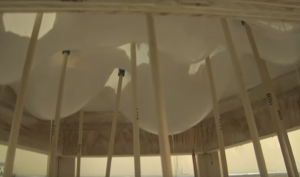This post is in response to Mimi Jiao’s looking outwards post from week three, which can be found here.
Andrew Kudless is an architect and professor who leads Matsys, a studio based in Oakland, California which does work at the intersection of form, growth, and material systems. Material systems, the central motif of the studio, refers to the interactions of a material’s biologic, geologic, and synthetic qualities.

I was drawn to the piece “P_Wall” in for the same reasons Mimi was. I feel a personal connection to the piece and a desire to interact with it through touch.
Mimi proposed the idea of an extension of this piece through the installation of a more interactive iteration. I am interested in this idea because of the indirect dialogue the piece would conduct amongst those who have engaged with the form.
After further research into the fabrication process for “P_Wall” I have found that although Matsys renders a the panel forms digitally, they also embrace the inaccuracies in how the concrete slurry settles into approximate equilibrium.

Mimi touched upon the connotations in the final organic form resembling that of a tree. I agree that the wall feels very natural, although I initially felt that the wall looked like a collection of torsos smoothly cropped out of context. The folds resemble that of a sitting or turning person.
This impression is in sharp contrast to the inflation test Matsys used in modeling a sister piece to P_Wall, titled Sevenstar (2011). The initial form of this piece reminds me of a tessellation of lounge cushions, inviting me to sit. As the render progresses, it comes to live and begins to warp in a breathing motion. The rendering process is mesmerizingly beautiful, placing me as a spectator to an abstract materialization of life.
![[OLD FALL 2018] 15-104 • Introduction to Computing for Creative Practice](wp-content/uploads/2020/08/stop-banner.png)